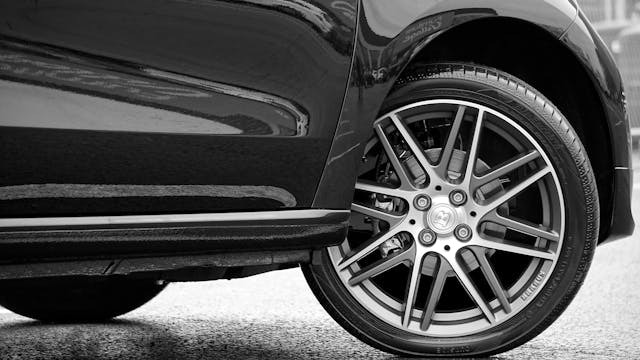We get it, life’s busy. Between work, errands, and dodging potholes like you’re in a video game, checking your tires doesn’t top the to-do list. Most folks glance at tread depth and call it a day. But your tires? They’re full of clues, whispers, and warning signs. And no, they’re not being dramatic at all.
Pop the hood—wait, the wheel well—open, and explore what really keeps you glued safely to the road.
Tire Pressure and Why It’s More Important Than You Think
Underinflated tires put extra risk on the road and wear out faster than you’d expect. They mess with your fuel economy, wear out faster, and get grumpy in emergency braking situations. Overinflated ones? Even worse. They’re like overfilled balloons waiting for a curb to ruin their day.
Most cars have a sticker on the driver’s side doorjamb with the recommended pressure. That’s your gold standard. Ignore it, and you’re riding on hope and friction.
Want your gas mileage not to cry every time you drive? Check that pressure monthly. No excuses. Cold mornings count double.
The Hidden Dangers of Uneven Tire Wear
So your tread is technically “legal”? Cool. But take a closer look. Is one side more worn than the other? Think of that as your tire’s way of sounding the alarm.
Uneven wear often screams, “Hey! Something’s wrong with alignment or suspension!” It’s like your tires are throwing a silent tantrum that shows up on your steering wheel.
Ignoring it can lead to:
- Wobbly handling
- Noisy drives that sound like a swarm of bees
- Shorter tire lifespan (and longer credit card statements)
Just peek now and then. It’s free and saves you from future headaches.
Sidewall Cracks and Bulges: Silent Signs of Tire Damage
This one’s sneaky. Most folks never glance at the sides of their tires—because, well, who crouches in parking lots for fun?
But bulges and cracks on the sidewall are like stress fractures. One hard bump and pop, you’re pulled over, wishing you’d looked sooner.
Even worse? Those bulges can be internal damage from hitting curbs or speed bumps too enthusiastically. You may not remember the bump, but your tire sure does.
Regularly checking your tires and even your windshield with a trusted Windshield Replacement company keeps small issues from turning into big roadside surprises.
How Tire Age Affects Your Safety on the Road
Think of tires like avocados—they don’t age gracefully. Even if the tread looks decent, the rubber breaks down over time. Sun exposure, heat, and just sitting still can turn them brittle and dangerous.
Manufacturers usually recommend changing tires every six years, regardless of how “okay” they seem. You’ll find the manufacturing date in an oval on the sidewall. It reads like a secret code: the last four digits tell you the week and year.
If it says 2319, that tire was born in the 23rd week of 2019. If it’s hitting its sixth birthday, consider a replacement party.
Why Tire Rotation and Alignment Are Not Optional
Think of rotation as chore-sharing. If one tire is doing all the work, it’s going to complain—loudly.
Rotating your tires every 5,000–7,500 miles keeps wear even and performance balanced. Front tires wear differently from rear ones due to steering and weight distribution. Rotation evens out the burden.
And alignment? That’s your car’s posture. If it’s slouching, drifting to the side, or shaking the wheel, it’s time for a checkup. A straight car is a safer, smoother car. You wouldn’t walk with one foot turned sideways and expect no pain, right?
Seasonal Tire Safety Checks Drivers Often Ignore
Seasons change, and so do driving conditions. Yet many folks treat summer tires like they’re invincible all year round. Spoiler alert: they’re not.
Here’s your seasonal checklist (yes, it’s the only bullet list you’ll see here):
- Spring: Check for cracks from winter cold snaps
- Summer: Watch out for overinflation from hot roads
- Fall: Inspect for uneven wear from summer road trips
- Winter: Cold air reduces pressure. Check it often
Bonus tip: Don’t mix tire types across axles unless you enjoy unpredictable skids.
Conclusion: Drive Safer by Seeing Beyond the Tread
Tires don’t need to shout to get your attention. But when they do speak up (via pressure drops, odd wear, or sidewall scars), you’d better listen.
Looking beyond tread depth is like reading the fine print. It’s not glamorous, but it keeps you from starring in your own roadside drama.
Next time you’re tempted to ignore those round, rubber lifesavers, remember: They’re the only thing between you and the pavement. Treat them like the MVPs they are.
Frequently Asked Questions
1. How often should I check my tire pressure?
At least once a month, and before long trips. Cold mornings? That’s when pressure drops sneak in the most.
2. Is uneven wear always a bad sign?
Yes. It usually means something’s off with your alignment, suspension, or rotation habits. Address it before it turns into something costlier.
3. Can old tires be safe if the tread looks okay?
Nope. Even with good tread, old rubber can crack or lose grip. Six years is generally the upper limit, even if they’re barely used.
4. What causes sidewall bulges?
Usually, impact damage—hitting a curb, pothole, or speed bump too hard. The internal structure gets compromised, making blowouts more likely.
5. Do I need to rotate all-wheel-drive vehicle tires, too?
Absolutely. In fact, it’s even more critical for AWD vehicles to maintain even tread depth to avoid drivetrain stress.






